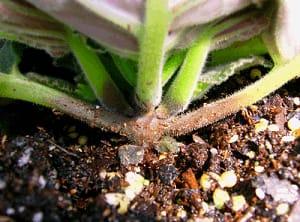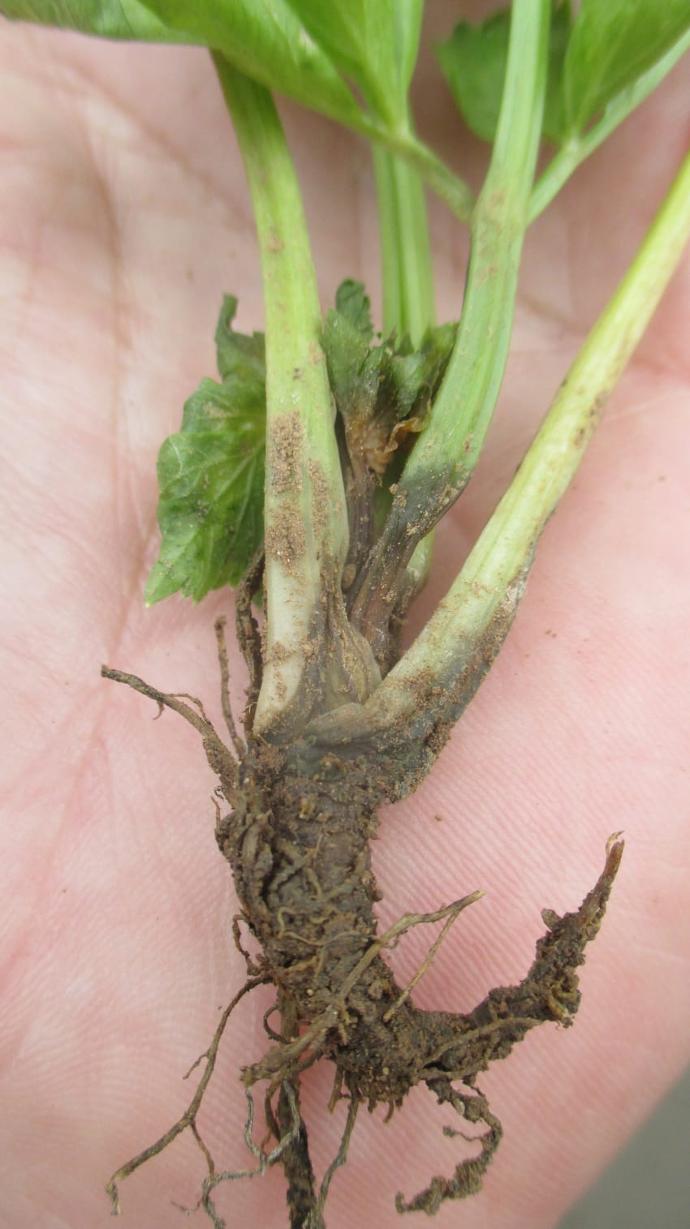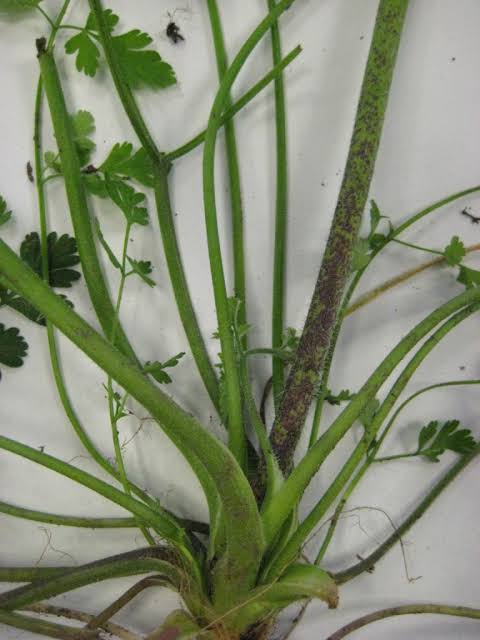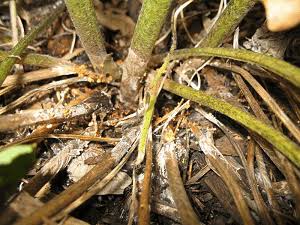Chervil Plant
Chervil, an annual, prefers well-drained, fertile soil and partial shade to full sun. It's frost-tolerant and fast-growing.
Habit
Annual
Height
30-60 cm
Growth
Fast
Soil
Well-drained loamy soil
Shade
Partial shade to Full Sun
Moisture
Moist
Edible
Yes
Medicinal
Yes
Origin
Europe, Asia
Climatic Condition
Temperate, Cool
Temperature (°)
10-20°C
Humidity (%)
50-80%
Potting media
Peat, compost
Fertilizers
NPK 5:10:10
Watering
Regular, moist soil
Plant Weight
50-150 g
Flowering Time
Spring, Early Summer
Soil Ph level
6.0 - 7.0
Water Ph level
6.0 - 7.0
Soil EC
1-2 dS/m
Yield Per Plant
500-1000 g per plant
NPK ratio
05:10:10
life Span
Annual (1 season)
Health Benefits
Digestive aid, rich in vitamins A & C
Suggested Grow Media or Potting Mix ?
40% compost, 30% peat moss, 30% perlite
Suggested Fertigation/Fertilizers
Fertilize every 2 weeks with a balanced, water-soluble fertilizer.
Common Diseases and Remedies
crown rot and stem rot.
Initial symptoms are small, irregular black lesions on the outer leaf sheath near water level. wilting of foliage, plant stunting, and drying and death of older leaves,
remove plant and burn it , and roughing the parts and plants
HEALTH BENEFITS
· Acts as a natural diuretic, helping with kidney and urinary health.
· Rich in vitamin C and A, boosting immunity and eye health.
· Contains antioxidants that support cardiovascular health.
· Aids in digestion and may relieve bloating.
What Is An Chervil Tree?
A tender annual plant belonging to the parsley family (Umbelliferae). Some important points about Chervil are: Appearance: Chervil has finely divided, fern-like leaves that resemble parsley or carrots. Grows bushy, reaching about 12 to 24 inches (30 to 60 cm) in height Flavor: Chervil has a delicate, mild flavor with hints of anise or licorice. Its taste is often compared to the combination of parsley and tarragon.

What Are The Different Types Of Areca Palm Plants?
1. Curled Chervi
This type of chervil has curled or finely divided leaves and is the most commonly cultivated variety. It has a delicate taste and is often used in cooking.
2. Flat-leaf chervi
Also known as "French chervil" or "plain chervil," this variety has flat, wide leaves and a flavor similar to curled chervil. It is popular in French cuisine and is often used fresh as a salad or side dish.
3. Deerfoot Chervil
Deerfoot chervil or Anthriscus sylvestris is a related species that looks similar to chervil but has wider, coarser leaves. It is sometimes used as a true chervil replacement in culinary applications.
4. Fern-leaf chervil
Fern-leaf chervil or Anthriscus nitidus is another related species with finely divided, fern-like leaves similar to the common chervil. It is native to the Mediterranean region and is sometimes used as a culinary herb.
5. Wild chervil
Wild chervil or Anthriscus caucalis is a common weed in many parts of the world. It is characterized by small white flowers and deeply lobed leaves. Although not usually grown for culinary purposes, it is edible and has a flavor similar to cultivated chervil.

What Are The Different Types Of Areca Palm Plants?
1. Location
Chervil can be grown in containers or in the ground in a location protected from the wind. It can be grown as a cool-season crop in spring or fall, or as an annual crop in warmer climates. In cool regions, it can self-sow and may emerge as a perennial herb the following year.
2. sunshine
Chervil prefers partial shade rather than full shade and does not tolerate direct sunlight. It can tolerate some morning sun, but must be protected from the hot afternoon sun. If chervil is grown in full sunlight, it will germinate or form seeds faster and the quality of the leaves will decrease. Therefore, it is important to choose a cool, shady location for your chervil that will protect it from intense sunlight and high temperatures. Locations that are exposed to direct sunlight for more than 6 hours a day are not suitable for growing chervil
3. soil
Chervil requires fertile, well-drained soil rich in organic matter. Soil pH should be between 6.5 and 7.0. Chervil grows best in soil that is moist but not soggy, as too much moisture can cause root rot. It will not grow in compacted soil without an air space, as root growth is inhibited and the plant may die.Before planting chervil, the soil should be loosened and mixed with compost or old manure to provide nutrients and improve soil structure. If your soil is heavy clay, you can mix in sand or perlite to improve drainage.
4. Hydration
Chervil requires constant moisture to keep the soil evenly moist. The soil should never be allowed to dry out, but should not be waterlogged. Overhead watering can cause fungal infections. Therefore, it is best to water the plant at ground level and avoid getting the leaves wet. Especially in hot and dry weather, it is recommended to water chervil regularly to prevent the soil from drying out. It is important not to overwater your chervil as this can cause root rot, especially if the soil is poorly drained. Seedlings and young plants are more susceptible to excess water.
5. Nutrition
It is important not to overwater your chervil. This can lead to root rot, especially if the soil is poorly drained. Seedlings and young plants are more susceptible to excess water. Chervil requires nitrogen, phosphorus, and potassium, the most important nutrients needed for plant growth. Nitrogen is especially important for chervil as it promotes healthy leaf growth. Compost tea, fish emulsion, and other organic fertilizers can be added to the soil to provide these nutrients and promote healthy growth. It is important not to overfertilize your chervil, as this can lead to excessive growth and reduced leaf quality. Chervil is not a large feeder, so it needs to be fed small amounts and frequently of organic substances, such as: B. Compost tea, promotes growth without excessive fertilization.

6) issues
Aphids, spider mites, and pumpkin bugs are some of the most common pests. There are also diseases such as powdery mildew and spot disease. Proper care and precautions can help reduce the risk of infestation and infection. Chervil can be difficult to grow in certain areas where there is a lot of competition from other plants. Proper spacing and timely weeding will help ensure optimal growth and yield.
What are the Benefits of chervil Plants ?
Nutritional Value: Chervil is an excellent source of vitamins and minerals such as vitamin C, vitamin A, iron, calcium, and magnesium.Digestive Health: Chervil is a natural digestive aid that reduces gas, bloating, and constipation.

FAQs About Growing Areca Palms
1. Can chervil be consumed raw?
Yes, chervil can be consumed raw and is often used as a garnish on soups, salads, and other dishes. Its delicate flavor makes it a great addition to fresh recipes.
2. What is the best way to store chervil?
The best way to store chervil is to wrap it in a damp paper towel and store it in a plastic bag in the refrigerator. It should stay fresh for up to a week.
3. How do you use chervil in cooking?
Chervil is a versatile herb that can be used in a variety of dishes. It is often added to soups, sauces, egg dishes, and salads as a fresh garnish or ingredient. Its delicate flavor makes it a great complement to seafood, chicken, and vegetables.
4. Can chervil be dried or frozen for later use?
Yes, chervil can be dried or frozen for later use. To dry chervil, hang it upside down in a cool, dry place until it is completely dry. To freeze chervil, chop it finely and place it in an ice cube tray with water or oil. Once frozen, pop the cubes out and store them in a plastic bag in the freezer.
5. Is chervil easy to grow?
Chervil is relatively easy to grow if the conditions are right. It prefers cool temperatures, moist soil, and partial shade. It can be grown indoors or outdoors and is often used as a border or edging plant.



